How to Request Feedback Revision From a Buyer on eBay

If you’ve been selling on eBay for a while, you know how important your reputation as a seller is. So, you’ll know that sinking feeling all too well when you open up your dashboard, and someone has left you a scathing review.
In a world where keyboard warriors are out in full force, dealing with negative feedback is something every online seller needs to learn. And it’s something of an art form. Instead of leaving out-of-line ratings in full view of potential buyers and damaging the reputation of the business you’ve worked hard to build, you can do something about it.
If you want to know how to remove negative feedback on eBay and deal with eBay disputes, we’ve got your ultimate guide to managing your feedback score like a pro.
Why do seller reviews on eBay matter?
Seller reviews on eBay are an essential part of the purchasing process for buyers. While shopping in a physical store, there are sales associates to answer questions and concerns, but when you sell online, your reviews become your ultimate salesperson.
Reviews provide insight into how you have conducted your business in the past, so buyers can make informed decisions about who they’re buying from. In fact, a 2023 survey found that 76% of shoppers always or regularly browse online reviews before making a purchase.
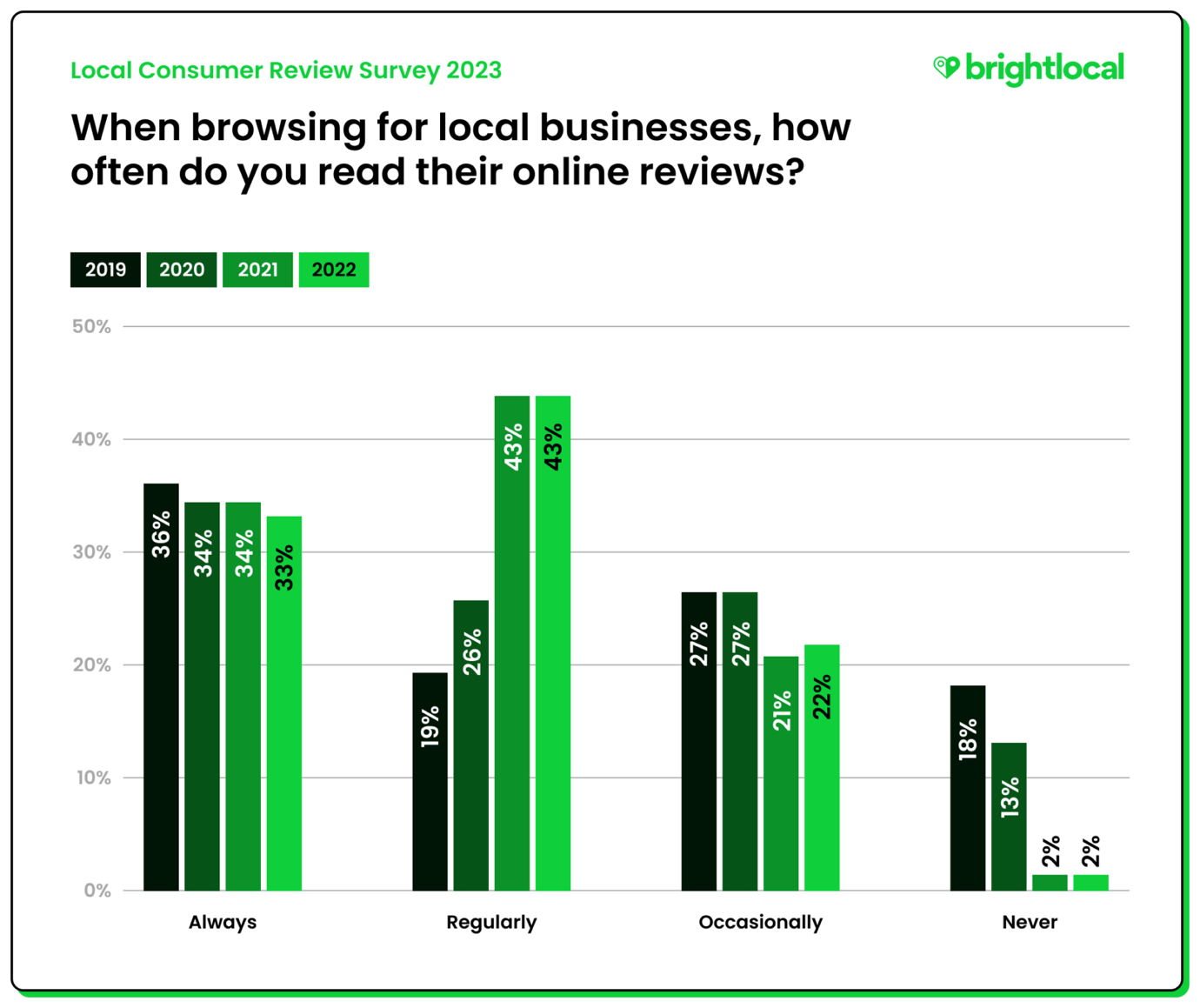
Here are some more reasons why seller reviews matter:
1. They can reveal important information
Reviews often include detailed accounts of customers’ experiences with sellers, giving potential buyers a good sense of what to expect if they purchase from a particular shop. By reading through customer feedback, buyers can determine how reliable and trustworthy a particular vendor is and avoid unpleasant experiences such as late shipping, poor-quality items, or scams.
Reviews also let potential customers know crucial product info, such as the benefits of a product, whether it works as intended, and how it makes life smoother.
2. They offer peace of mind
Many shoppers feel more secure when buying from a seller with multiple positive reviews.
Seeing positive feedback provides reassurance they won’t encounter any problems or issues during the transaction. It can also provide insight into how order issues are handled and resolved, setting realistic customer service expectations and making buyers feel more at ease buying from you.
3. They build trust between buyer and seller
Good reviews demonstrate that previous customers have had successful transactions with you before, which builds trust and credibility.
This level of mutual trust and respect allows for smoother interactions throughout each step of the purchase journey because both of you can let your guard down and not jump on the defensive. It could also mean repeat business down the line, especially if you live up to the expectations set by your existing glowing reviews.
4. They help listing visibility
Sellers with high feedback scores of at least 98% or 4 out of 5 stars will rank higher in eBay search results. This improved visibility helps you increase your chances of making sales, getting repeat business, or growing awareness of your brand.
Feedback doesn’t only apply to sellers but buyers too! Sellers can review their experience with a buyer and flag any inappropriate behavior. This can help warn other sellers to avoid transactions with difficult buyers or scammers.
Still not convinced reviews are that important? Think again! Check out these customer review stats for the cold hard facts. Bottom line? Reviews matter…a lot!
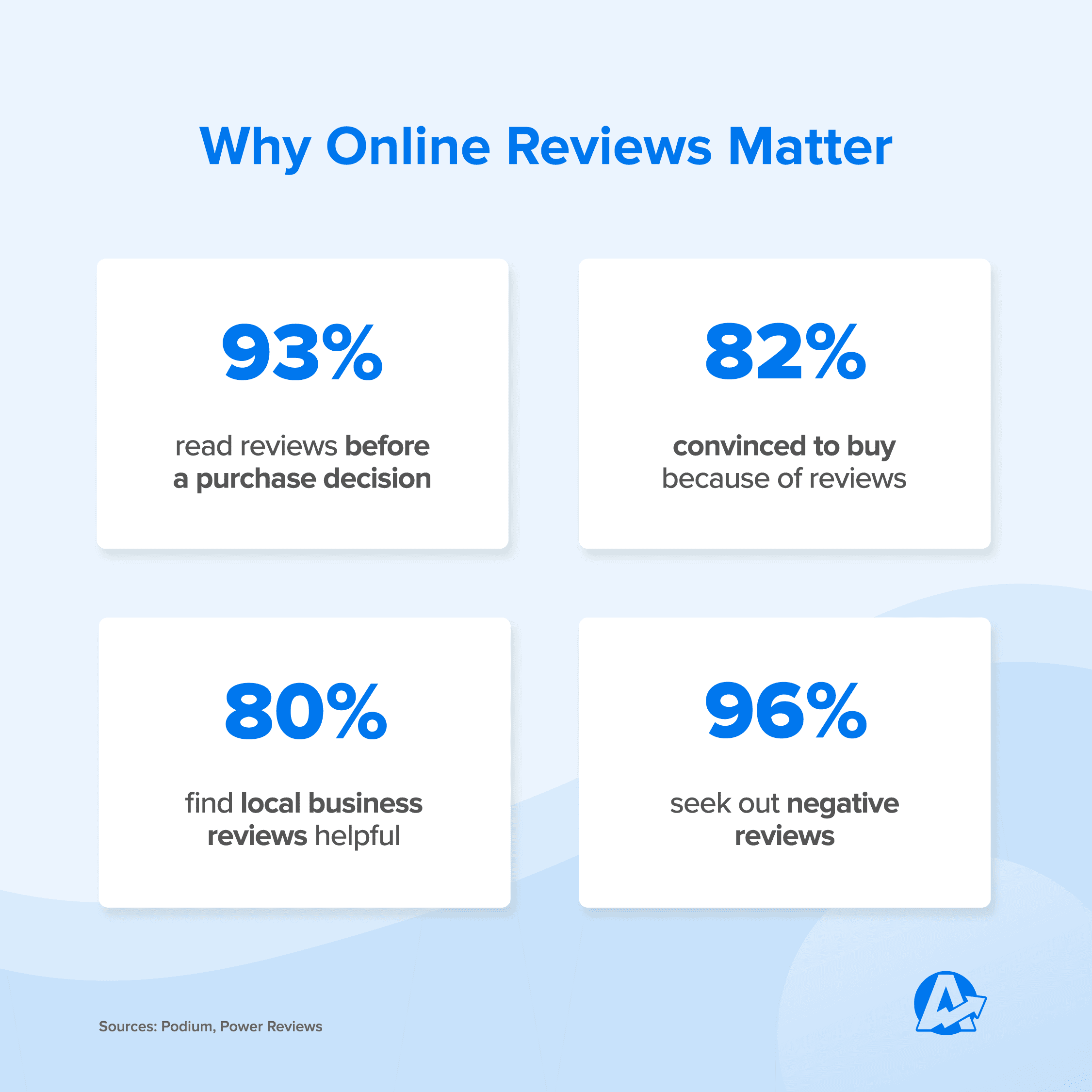
eBay’s review system provides a great opportunity for sellers to build customer relationships and loyalty while helping shoppers make more confident purchasing decisions.
👉 Read our guide on how to get 5-star reviews as an online seller
What is eBay feedback?
eBay feedback is a system that allows buyers and sellers to rate their experience after a successful purchase or sale. This feedback includes an overall rating of positive, neutral, or negative and comments about the experience. The purpose of this system is to help build trust between buyers and sellers on eBay.
Sellers with high ratings are more likely to attract new customers while increasing sales from repeat business. This is because buyers use feedback scores to determine whether they want to do business with a particular seller.
eBay feedback is crucial because it helps create transparency within the platform by holding buyers and sellers accountable for their actions during sales. As such, it encourages honesty and fairness among all parties buying and selling on eBay.
What is eBay’s feedback score?
eBay’s Feedback Score is a numerical rating that reflects the overall satisfaction level of buyers with a seller’s performance. It serves as an indicator of how well the seller has performed in their past transactions on eBay.
Your first-time buyers are complete strangers and know nothing about you or your store…so this feedback score is crucial to attracting new customers and building enough trust for them to make a purchase.
The feedback score is expressed as a percentage of positive feedback received in the past 12 months. The seller rating is a separate review system that gives you a rating of between 1 and 5 based on:
- Item description
- Communication
- Shipping timelines
- Any hidden charges
To maintain a high feedback score, you must consistently provide excellent customer service, communicate effectively with buyers, deliver items promptly, and accurately describe the item in your listings. A lower score may indicate issues with any of these areas or other negative experiences reported by previous buyers.
Buyers can also leave detailed comments and ratings through eBay’s feedback system. This allows potential buyers to understand better what they can expect when buying from a particular seller.
Your feedback score is critical because it is directly tied to your visibility. eBay’s search engine will immediately decrease your visibility when there is an unresolved eBay dispute or negative review, limiting your chances of landing “Best Match” placements. Your search engine rankings will only bounce back once the issue has been resolved.
As mentioned, a feedback score under 98% will impact your visibility. A bit of problem-solving will tell you that if you sell 100 products in a month, you cannot get more than two negative reviews. And the sad reality is that buyers are more inclined to leave a bad review if they’ve had a negative experience than if theirs was a positive one.
In fact, almost 70% of buyers won’t leave a review unless they are reminded to do so (more on that later).
Maintaining a high feedback score can earn you a PowerSeller badge, which also boosts your visibility and rankings. Below is an example of your feedback profile on eBay, where you will spot all the elements we discussed above.
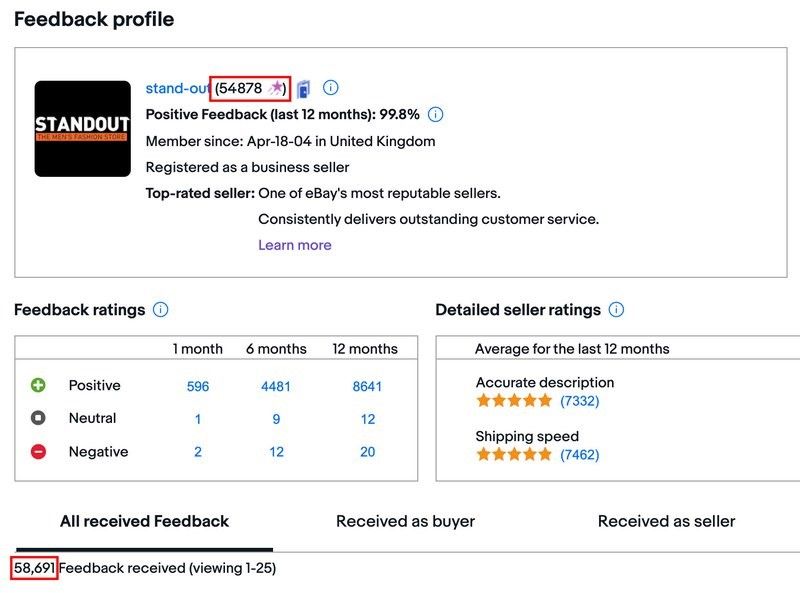
Is there fake feedback on eBay?
Sadly, there are many vindictive people in the world, and they can leave fake feedback on eBay. Competitors may do this to try and manipulate the rating system to increase their own ratings or negatively affect another user’s ratings. They can also be exaggerations or honest misunderstandings between buyers and sellers.
Some examples of fake feedback include:
- Leaving overly positive reviews with no substance behind them (e.g., “Excellent transaction! A+!” without any further explanation). This type of review can look suspicious to potential buyers and seem like the seller has been adding fake reviews to boost their feedback score.
- Leaving neutral or negative comments about sellers when there was nothing wrong with their product or service (i.e., “The item I received didn’t look like what was pictured” even though it did).
- Fabricating stories about how items were damaged during shipping, describing issues that never really occurred, and falsely claiming that refunds had not been issued when they were.
Negative reviews can be a real slap in the face for sellers who have tried their best to resolve an issue or maintain good communication with a buyer. The reality is that some difficult people in the world are impossible to please.
No matter what you say or do, they will never be satisfied, so it’s best to try and move on from these types of transactions and check buyer ratings for any red flags before carrying out future sales.
It is important to note that eBay has policies to protect users from receiving false feedback and encourages its members to report suspicious activity accordingly. If you suspect someone may have left you unjustified negative ratings or comments, then you should contact eBay immediately, so they can investigate further and take appropriate action if necessary.
Is eBay feedback private?
One question that often arises among eBay buyers and sellers is whether or not feedback on the platform is private. The answer to this question is both yes and no, depending on the situation.
When a buyer leaves feedback for a seller, the comment itself is public and can be seen by anyone browsing their profile or listing. However, certain information about the transaction, such as the purchase price and any communication between buyer and seller, will remain private.
Similarly, when a seller leaves feedback for a buyer, it will be visible on their profile but may not include specific details about the transaction. Additionally, eBay allows buyers to leave anonymous feedback if they choose.
While some aspects of eBay feedback are kept private to protect personal information and maintain anonymity, most comments are viewable by others on the platform. As always, reviewing all relevant policies before making transactions or giving out personal data online is essential.
How to spot fake feedback and reviews on eBay
Spotting fake feedback on eBay can be tricky, but there are some key things to look for that can help you identify potential fraudulent reviews.
Language and tone
You should pay attention to the language used in the feedback. Fake reviews tend to use overly positive language or may even contain blatant lies about a product’s greatness.
Additionally, look out for repetitive phrases or words used across multiple reviews, as this could indicate someone copying and pasting from elsewhere – another tell-tale sign of fraud. Here is an example of what this could look like:
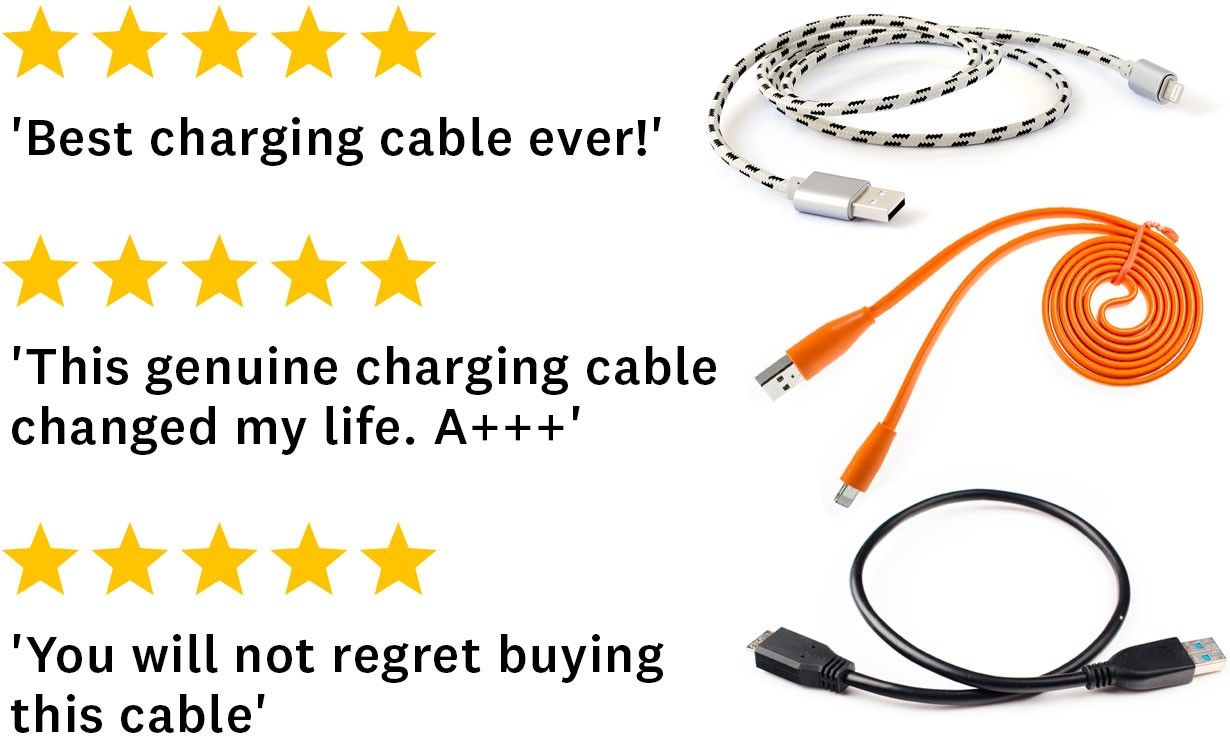
New accounts
You should also take note if all of the feedback is coming from recently created accounts with no previous activity. These accounts may have been created solely to leave fake ratings on listings.
Furthermore, if the account was only active during a specific period (such as when a seller was running promotions), then it’s likely they were paid by people associated with that seller to leave glowing comments, or they’re a competitor account trying to damage the reputation of your business.
Dive deeper
It’s important to read between the lines by looking at what isn’t said rather than just what is stated in each review.
If all of them mention little detail beyond “great item!” then it could indicate something fishy going on behind closed doors. Excessively positive or negative reviews are likely fake because genuine buyers tend to leave more balanced, honest reviews.
Relevance
Keep an eye out for vague or irrelevant comments that don’t relate to the product being sold – these may have been copied and pasted from elsewhere to damage the business’s reputation or, conversely, boost their reputation through fake paid reviews.
Best practices when replying to feedback on eBay
Dealing with negative feedback is a part of selling online that every seller must come to grips with if they hope to succeed. Responding to positive and negative feedback can improve your feedback score and seller ratings. Here are some important things to keep in mind when replying to feedback on eBay:
Be prompt
Always respond promptly and courteously to all types of feedback – positive, neutral, or negative. Thank the buyer for leaving their comments and addressing any issues they may have raised professionally.
Short responses
Keep your responses short and sweet while remaining informative. Avoid getting into heated arguments with buyers, which could lead to more negative feedback.
Edit and proofread
Make sure you proofread your responses before submitting them to avoid any grammatical or spelling errors that could damage your credibility as a seller.
Remember that potential customers may read through previous reviews before purchasing from you, so ensure all communication is respectful toward the buyer’s experience.
Here is some expert advice on how to handle negative reviews without breaking a sweat:

Following these best practices will help maintain good relationships with past customers and attract new ones who value excellent customer service.
How to get negative feedback removed on eBay
Negative feedback can be a significant blow to your eBay business, but there are measures you can take to get it removed. While it is challenging to eliminate ALL negative feedback, you do have a few eBay feedback removal options when it comes to damage control.
Option 1: Ask the buyer to remove the feedback
Your best option is to contact your buyer directly and attempt to resolve any issues brought up in their review.
If you successfully resolve the issue, you can move on to requesting that they revise or remove their feedback. Should they agree to do this, you will need to send them a feedback revision request. This will prompt them to update their feedback score.
The catch is you can only request five feedback revisions for every 1000 reviews you receive. This is in place to uphold eBay sellers to high customer service standards rather than attempting to fix errors at a later stage.
Because feedback revision requests are limited, you should only use them for very damaging or false reviews and not for neutral reviews. Always contact customers before sending a revision request, as you don’t want to waste a request on a buyer who isn’t willing to change their feedback.
It’s also important to note that revision requests must be made within 30 days of a review being posted, so you should constantly monitor your feedback and reach out when necessary in due time. Below is an example of your feedback revision request dashboard with reviews that are eligible for revisions.
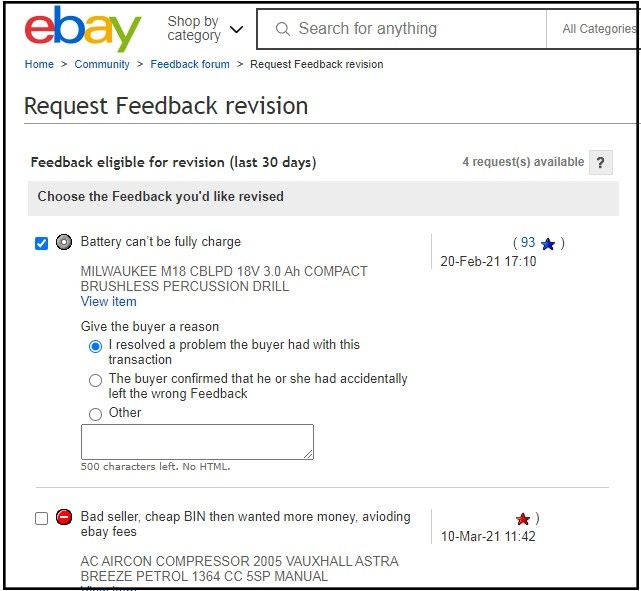
Option 2: Report the review to eBay
If the negative feedback is inaccurate, abusive, or violates eBay’s policies, you can contact eBay customer support and request removal. You should provide evidence that supports your claim, such as screenshots of communication with the buyer.
To do this, you will need to report the review to be assessed by eBay’s moderators. Navigate to the seller reporting hub and lodge your complaint within 90 days of the original purchase date.
Generally, eBay is quick to respond and investigate reports of this nature, and where the review is in breach of policies, it will be removed. However, sometimes the rating itself is left behind, and only the comment is removed, so do keep this in mind, as then you are stuck with a bad rating and no context.
Option 3: Drum up positive reviews
If all else fails, try burying the negative feedback by generating more positive reviews for your account. Encourage satisfied customers to leave positive reviews on your page through follow-up emails or discounts on future purchases.
Remember that maintaining good customer relations and providing excellent service is vital to preventing negative feedback in the first place. Respond promptly to inquiries or complaints and ensure products are shipped out speedily to meet customer expectations.
Option 4: Respond publicly
88% of shoppers will read sellers’ responses to reviews, if only to just see whether the seller cares about customer problems and works on fixing them. So, you must respond to negative or neutral reviews if you cannot get them removed or revised. Respond to baseless claims in a calm, professional, and factual way. In the same breath, if the mistake was your fault, take ownership, apologize, and explain the steps you have taken to remedy the situation.
Option 5: Diversify
It is never wise to put all your eggs in one basket, so if you’re successfully selling on eBay, it’s time to diversify and start selling on other online platforms. When you sell on multiple channels, you open your business up to several benefits, including:
- New in-built audiences and larger reach
- New marketing tools
- Increased visibility
- Less risk in relying on one channel for income
- More sales
- Access to niche markets
Sell on multiple platforms with Crosslist
Using a cross posting app like Crosslist makes selling across multiple sales channels seamless by managing your inventory from one location. You can edit and update listings in one place and upload them across multiple marketplaces in bulk batches, saving you precious time and improving your odds of making sales!
With Crosslist, you can create a single listing and post it to multiple platforms simultaneously. Our tool also supports Shopify in case you want to set up your own e-commerce store (so that you have full control over store policies, fees, and so on).
If you’re already selling on eBay and want to expand to other platforms, you can simply import your inventory to Crosslist and then cross post it elsewhere — all in one go.
👉 Read our guide on how to cross list from eBay to Poshmark
While these are not foolproof eBay feedback removal techniques, they go a long way in helping you manage your reputation as a seller by demonstrating your commitment to exemplary customer service.
How an eBay feedback revision request works
Requesting an eBay feedback revision request can be an effective way for sellers to maintain their reputation and ensure accurate representation of transactions with buyers.
The first step in requesting a feedback revision is to contact the buyer directly through eBay’s messaging system. It’s essential to remain professional and courteous when requesting a revision and explain why you feel it is necessary.
If there is a problem with their order, find a way to resolve the issue to the buyer’s satisfaction. Remember to be aware of all the eBay seller fees you are liable for and whether any additional fees will apply if you were to issue a refund or ship out a replacement product.
If the buyer agrees to revise their feedback, you will need to send them a feedback revision request.
Once revised, eBay will update your overall Feedback Score accordingly. If the buyer chooses not to revise their comment or if they do not respond within ten days of your initial request, unfortunately, no further action can be taken.
Conclusion
eBay feedback is an important aspect of the platform that helps build trust between buyers and sellers. As a seller, you should strive to maintain a good feedback score by providing quality service and responding professionally to negative reviews. Knowing how to identify fake feedback and handle disputes effectively is also essential.
If you receive negative feedback that you believe is unjustified or violates eBay policies, there are steps you can take to get it removed. And if you need to request a revision from a buyer who has left negative feedback for your account, don’t hesitate to reach out through eBay’s messaging system.
By following these best practices and proactively managing your eBay feedback score, you can establish yourself as a reliable seller on the platform and attract more customers over time. For more tips on growing your online empire, check out our recent post on how to start an online business, which is packed with useful hints and tips.
Questions or just say hello!
Well, congratulations to you for making it this far! Here’s a reward in the form of a 10% discount code on your first month of Crosslist (add during check-out). Sign up now with a 3-day money-back guarantee!
10% off
BLOG10
You can learn more about how Crosslist works here.
If you have further questions, feedback, bug reports, or want to know a bit more about us, why not swing by for a chat and say G’day! You can have a chat with us through Messenger.
